Customer Attrition Impact on Tesco's Profitability: A Detailed Report
VerifiedAdded on 2023/04/25
|27
|8675
|208
Report
AI Summary
This report examines the impact of high customer attrition on Tesco's profitability and market share between 2015 and 2018. It identifies factors contributing to customer attrition, such as failure to adapt to e-commerce trends and aggressive pricing by competitors. The report uses secondary data from Tesco's official website, newspaper articles, and peer-reviewed articles to demonstrate the decline in Tesco's revenue, share price, and market share during this period. It also highlights the strategies Tesco implemented to mitigate customer attrition and improve profitability. The analysis includes financial figures and market share comparisons to illustrate the extent of the impact and the subsequent recovery efforts. Desklib offers a variety of resources including solved assignments.
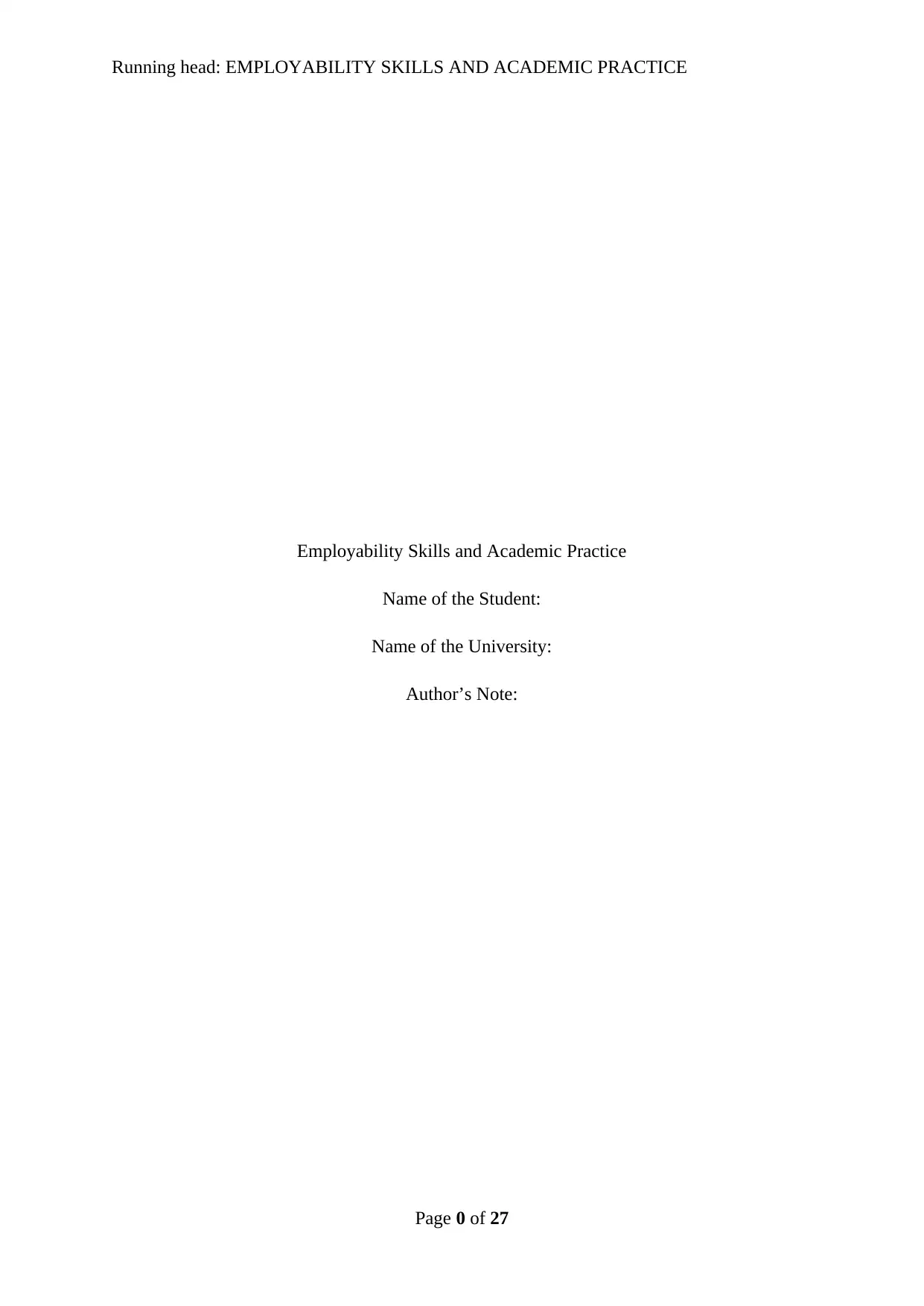
Running head: EMPLOYABILITY SKILLS AND ACADEMIC PRACTICE
Employability Skills and Academic Practice
Name of the Student:
Name of the University:
Author’s Note:
Page 0 of 27
Employability Skills and Academic Practice
Name of the Student:
Name of the University:
Author’s Note:
Page 0 of 27
Paraphrase This Document
Need a fresh take? Get an instant paraphrase of this document with our AI Paraphraser
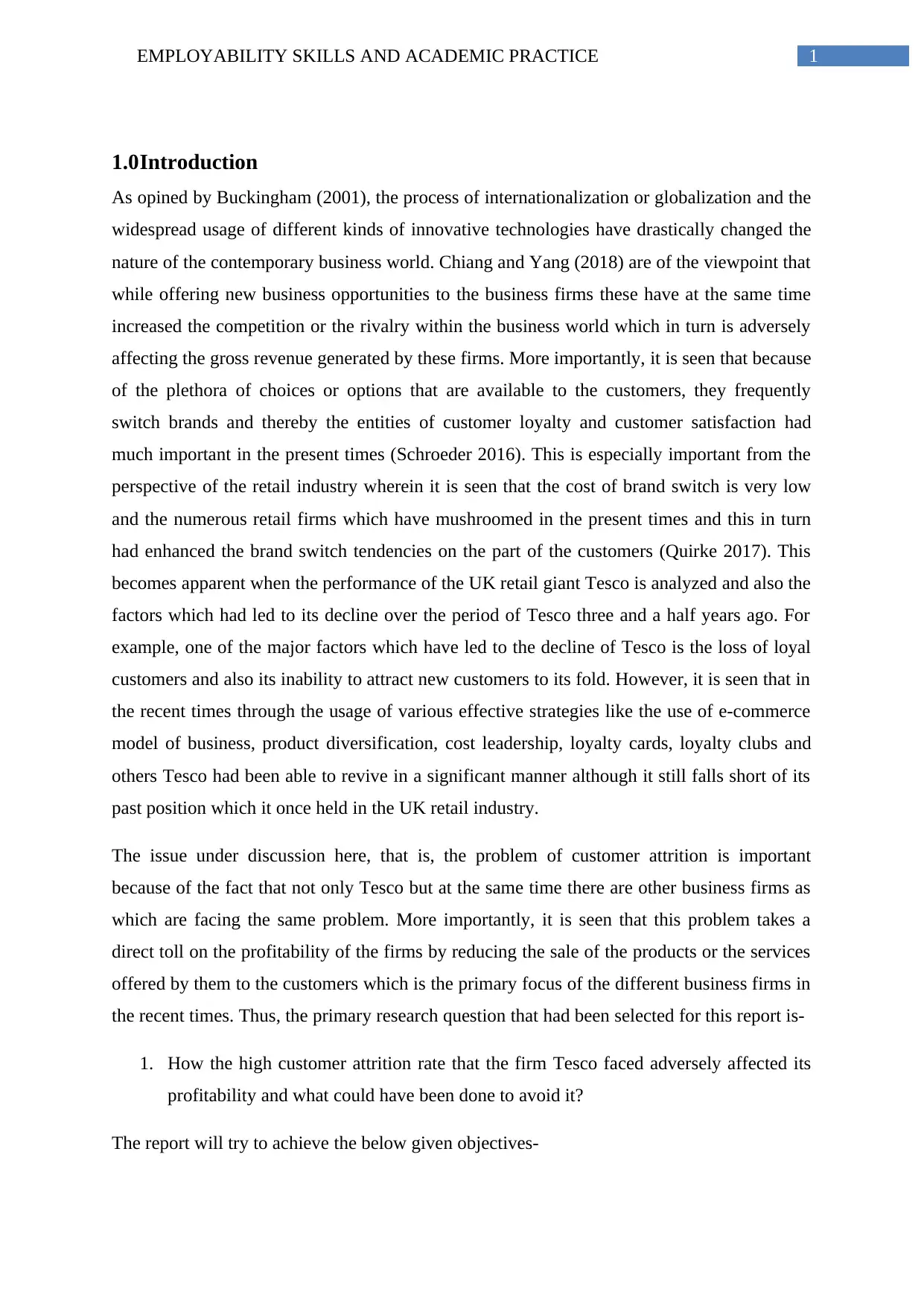
1EMPLOYABILITY SKILLS AND ACADEMIC PRACTICE
1.0Introduction
As opined by Buckingham (2001), the process of internationalization or globalization and the
widespread usage of different kinds of innovative technologies have drastically changed the
nature of the contemporary business world. Chiang and Yang (2018) are of the viewpoint that
while offering new business opportunities to the business firms these have at the same time
increased the competition or the rivalry within the business world which in turn is adversely
affecting the gross revenue generated by these firms. More importantly, it is seen that because
of the plethora of choices or options that are available to the customers, they frequently
switch brands and thereby the entities of customer loyalty and customer satisfaction had
much important in the present times (Schroeder 2016). This is especially important from the
perspective of the retail industry wherein it is seen that the cost of brand switch is very low
and the numerous retail firms which have mushroomed in the present times and this in turn
had enhanced the brand switch tendencies on the part of the customers (Quirke 2017). This
becomes apparent when the performance of the UK retail giant Tesco is analyzed and also the
factors which had led to its decline over the period of Tesco three and a half years ago. For
example, one of the major factors which have led to the decline of Tesco is the loss of loyal
customers and also its inability to attract new customers to its fold. However, it is seen that in
the recent times through the usage of various effective strategies like the use of e-commerce
model of business, product diversification, cost leadership, loyalty cards, loyalty clubs and
others Tesco had been able to revive in a significant manner although it still falls short of its
past position which it once held in the UK retail industry.
The issue under discussion here, that is, the problem of customer attrition is important
because of the fact that not only Tesco but at the same time there are other business firms as
which are facing the same problem. More importantly, it is seen that this problem takes a
direct toll on the profitability of the firms by reducing the sale of the products or the services
offered by them to the customers which is the primary focus of the different business firms in
the recent times. Thus, the primary research question that had been selected for this report is-
1. How the high customer attrition rate that the firm Tesco faced adversely affected its
profitability and what could have been done to avoid it?
The report will try to achieve the below given objectives-
1.0Introduction
As opined by Buckingham (2001), the process of internationalization or globalization and the
widespread usage of different kinds of innovative technologies have drastically changed the
nature of the contemporary business world. Chiang and Yang (2018) are of the viewpoint that
while offering new business opportunities to the business firms these have at the same time
increased the competition or the rivalry within the business world which in turn is adversely
affecting the gross revenue generated by these firms. More importantly, it is seen that because
of the plethora of choices or options that are available to the customers, they frequently
switch brands and thereby the entities of customer loyalty and customer satisfaction had
much important in the present times (Schroeder 2016). This is especially important from the
perspective of the retail industry wherein it is seen that the cost of brand switch is very low
and the numerous retail firms which have mushroomed in the present times and this in turn
had enhanced the brand switch tendencies on the part of the customers (Quirke 2017). This
becomes apparent when the performance of the UK retail giant Tesco is analyzed and also the
factors which had led to its decline over the period of Tesco three and a half years ago. For
example, one of the major factors which have led to the decline of Tesco is the loss of loyal
customers and also its inability to attract new customers to its fold. However, it is seen that in
the recent times through the usage of various effective strategies like the use of e-commerce
model of business, product diversification, cost leadership, loyalty cards, loyalty clubs and
others Tesco had been able to revive in a significant manner although it still falls short of its
past position which it once held in the UK retail industry.
The issue under discussion here, that is, the problem of customer attrition is important
because of the fact that not only Tesco but at the same time there are other business firms as
which are facing the same problem. More importantly, it is seen that this problem takes a
direct toll on the profitability of the firms by reducing the sale of the products or the services
offered by them to the customers which is the primary focus of the different business firms in
the recent times. Thus, the primary research question that had been selected for this report is-
1. How the high customer attrition rate that the firm Tesco faced adversely affected its
profitability and what could have been done to avoid it?
The report will try to achieve the below given objectives-
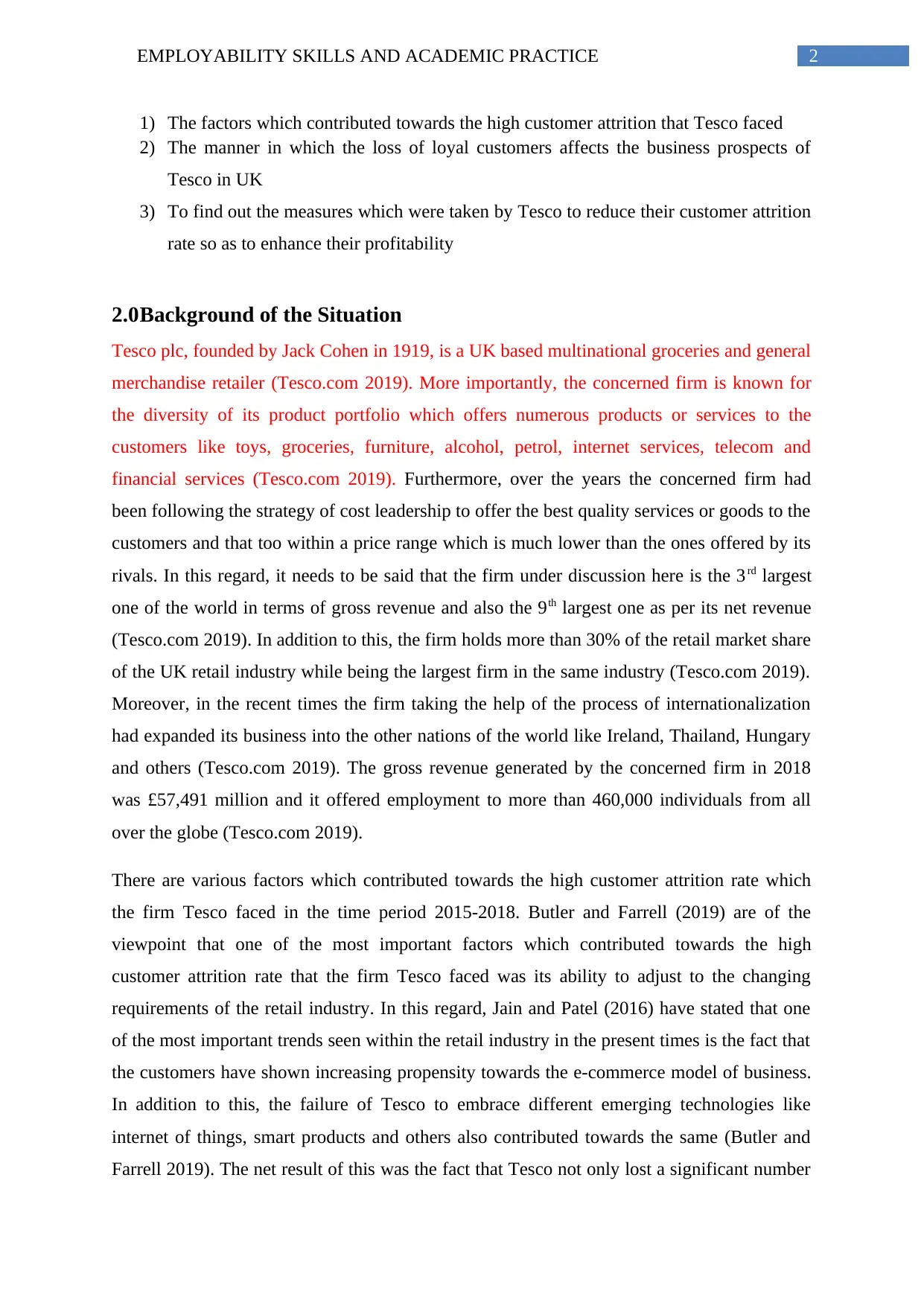
2EMPLOYABILITY SKILLS AND ACADEMIC PRACTICE
1) The factors which contributed towards the high customer attrition that Tesco faced
2) The manner in which the loss of loyal customers affects the business prospects of
Tesco in UK
3) To find out the measures which were taken by Tesco to reduce their customer attrition
rate so as to enhance their profitability
2.0Background of the Situation
Tesco plc, founded by Jack Cohen in 1919, is a UK based multinational groceries and general
merchandise retailer (Tesco.com 2019). More importantly, the concerned firm is known for
the diversity of its product portfolio which offers numerous products or services to the
customers like toys, groceries, furniture, alcohol, petrol, internet services, telecom and
financial services (Tesco.com 2019). Furthermore, over the years the concerned firm had
been following the strategy of cost leadership to offer the best quality services or goods to the
customers and that too within a price range which is much lower than the ones offered by its
rivals. In this regard, it needs to be said that the firm under discussion here is the 3rd largest
one of the world in terms of gross revenue and also the 9th largest one as per its net revenue
(Tesco.com 2019). In addition to this, the firm holds more than 30% of the retail market share
of the UK retail industry while being the largest firm in the same industry (Tesco.com 2019).
Moreover, in the recent times the firm taking the help of the process of internationalization
had expanded its business into the other nations of the world like Ireland, Thailand, Hungary
and others (Tesco.com 2019). The gross revenue generated by the concerned firm in 2018
was £57,491 million and it offered employment to more than 460,000 individuals from all
over the globe (Tesco.com 2019).
There are various factors which contributed towards the high customer attrition rate which
the firm Tesco faced in the time period 2015-2018. Butler and Farrell (2019) are of the
viewpoint that one of the most important factors which contributed towards the high
customer attrition rate that the firm Tesco faced was its ability to adjust to the changing
requirements of the retail industry. In this regard, Jain and Patel (2016) have stated that one
of the most important trends seen within the retail industry in the present times is the fact that
the customers have shown increasing propensity towards the e-commerce model of business.
In addition to this, the failure of Tesco to embrace different emerging technologies like
internet of things, smart products and others also contributed towards the same (Butler and
Farrell 2019). The net result of this was the fact that Tesco not only lost a significant number
1) The factors which contributed towards the high customer attrition that Tesco faced
2) The manner in which the loss of loyal customers affects the business prospects of
Tesco in UK
3) To find out the measures which were taken by Tesco to reduce their customer attrition
rate so as to enhance their profitability
2.0Background of the Situation
Tesco plc, founded by Jack Cohen in 1919, is a UK based multinational groceries and general
merchandise retailer (Tesco.com 2019). More importantly, the concerned firm is known for
the diversity of its product portfolio which offers numerous products or services to the
customers like toys, groceries, furniture, alcohol, petrol, internet services, telecom and
financial services (Tesco.com 2019). Furthermore, over the years the concerned firm had
been following the strategy of cost leadership to offer the best quality services or goods to the
customers and that too within a price range which is much lower than the ones offered by its
rivals. In this regard, it needs to be said that the firm under discussion here is the 3rd largest
one of the world in terms of gross revenue and also the 9th largest one as per its net revenue
(Tesco.com 2019). In addition to this, the firm holds more than 30% of the retail market share
of the UK retail industry while being the largest firm in the same industry (Tesco.com 2019).
Moreover, in the recent times the firm taking the help of the process of internationalization
had expanded its business into the other nations of the world like Ireland, Thailand, Hungary
and others (Tesco.com 2019). The gross revenue generated by the concerned firm in 2018
was £57,491 million and it offered employment to more than 460,000 individuals from all
over the globe (Tesco.com 2019).
There are various factors which contributed towards the high customer attrition rate which
the firm Tesco faced in the time period 2015-2018. Butler and Farrell (2019) are of the
viewpoint that one of the most important factors which contributed towards the high
customer attrition rate that the firm Tesco faced was its ability to adjust to the changing
requirements of the retail industry. In this regard, Jain and Patel (2016) have stated that one
of the most important trends seen within the retail industry in the present times is the fact that
the customers have shown increasing propensity towards the e-commerce model of business.
In addition to this, the failure of Tesco to embrace different emerging technologies like
internet of things, smart products and others also contributed towards the same (Butler and
Farrell 2019). The net result of this was the fact that Tesco not only lost a significant number
⊘ This is a preview!⊘
Do you want full access?
Subscribe today to unlock all pages.

Trusted by 1+ million students worldwide
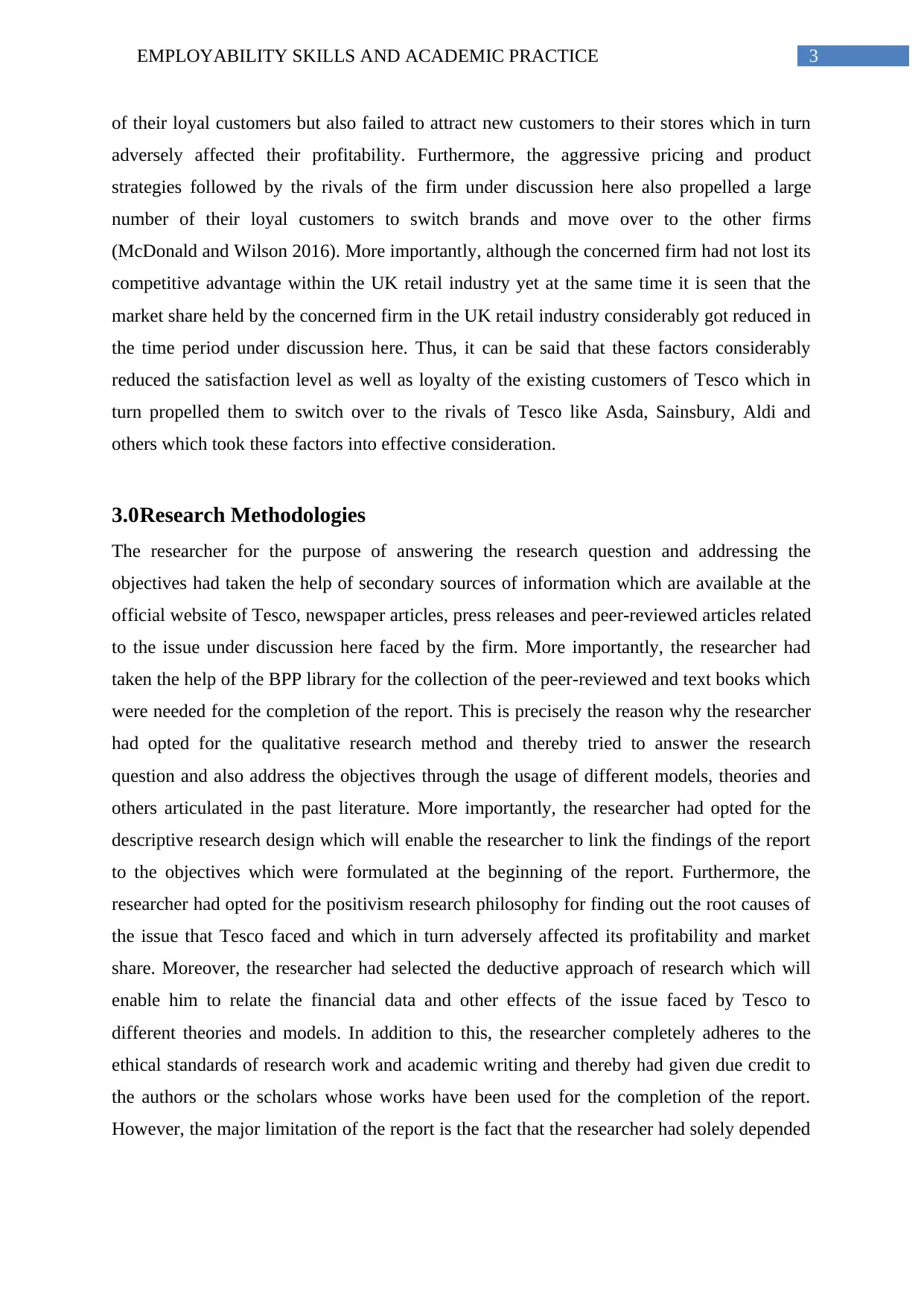
3EMPLOYABILITY SKILLS AND ACADEMIC PRACTICE
of their loyal customers but also failed to attract new customers to their stores which in turn
adversely affected their profitability. Furthermore, the aggressive pricing and product
strategies followed by the rivals of the firm under discussion here also propelled a large
number of their loyal customers to switch brands and move over to the other firms
(McDonald and Wilson 2016). More importantly, although the concerned firm had not lost its
competitive advantage within the UK retail industry yet at the same time it is seen that the
market share held by the concerned firm in the UK retail industry considerably got reduced in
the time period under discussion here. Thus, it can be said that these factors considerably
reduced the satisfaction level as well as loyalty of the existing customers of Tesco which in
turn propelled them to switch over to the rivals of Tesco like Asda, Sainsbury, Aldi and
others which took these factors into effective consideration.
3.0Research Methodologies
The researcher for the purpose of answering the research question and addressing the
objectives had taken the help of secondary sources of information which are available at the
official website of Tesco, newspaper articles, press releases and peer-reviewed articles related
to the issue under discussion here faced by the firm. More importantly, the researcher had
taken the help of the BPP library for the collection of the peer-reviewed and text books which
were needed for the completion of the report. This is precisely the reason why the researcher
had opted for the qualitative research method and thereby tried to answer the research
question and also address the objectives through the usage of different models, theories and
others articulated in the past literature. More importantly, the researcher had opted for the
descriptive research design which will enable the researcher to link the findings of the report
to the objectives which were formulated at the beginning of the report. Furthermore, the
researcher had opted for the positivism research philosophy for finding out the root causes of
the issue that Tesco faced and which in turn adversely affected its profitability and market
share. Moreover, the researcher had selected the deductive approach of research which will
enable him to relate the financial data and other effects of the issue faced by Tesco to
different theories and models. In addition to this, the researcher completely adheres to the
ethical standards of research work and academic writing and thereby had given due credit to
the authors or the scholars whose works have been used for the completion of the report.
However, the major limitation of the report is the fact that the researcher had solely depended
of their loyal customers but also failed to attract new customers to their stores which in turn
adversely affected their profitability. Furthermore, the aggressive pricing and product
strategies followed by the rivals of the firm under discussion here also propelled a large
number of their loyal customers to switch brands and move over to the other firms
(McDonald and Wilson 2016). More importantly, although the concerned firm had not lost its
competitive advantage within the UK retail industry yet at the same time it is seen that the
market share held by the concerned firm in the UK retail industry considerably got reduced in
the time period under discussion here. Thus, it can be said that these factors considerably
reduced the satisfaction level as well as loyalty of the existing customers of Tesco which in
turn propelled them to switch over to the rivals of Tesco like Asda, Sainsbury, Aldi and
others which took these factors into effective consideration.
3.0Research Methodologies
The researcher for the purpose of answering the research question and addressing the
objectives had taken the help of secondary sources of information which are available at the
official website of Tesco, newspaper articles, press releases and peer-reviewed articles related
to the issue under discussion here faced by the firm. More importantly, the researcher had
taken the help of the BPP library for the collection of the peer-reviewed and text books which
were needed for the completion of the report. This is precisely the reason why the researcher
had opted for the qualitative research method and thereby tried to answer the research
question and also address the objectives through the usage of different models, theories and
others articulated in the past literature. More importantly, the researcher had opted for the
descriptive research design which will enable the researcher to link the findings of the report
to the objectives which were formulated at the beginning of the report. Furthermore, the
researcher had opted for the positivism research philosophy for finding out the root causes of
the issue that Tesco faced and which in turn adversely affected its profitability and market
share. Moreover, the researcher had selected the deductive approach of research which will
enable him to relate the financial data and other effects of the issue faced by Tesco to
different theories and models. In addition to this, the researcher completely adheres to the
ethical standards of research work and academic writing and thereby had given due credit to
the authors or the scholars whose works have been used for the completion of the report.
However, the major limitation of the report is the fact that the researcher had solely depended
Paraphrase This Document
Need a fresh take? Get an instant paraphrase of this document with our AI Paraphraser
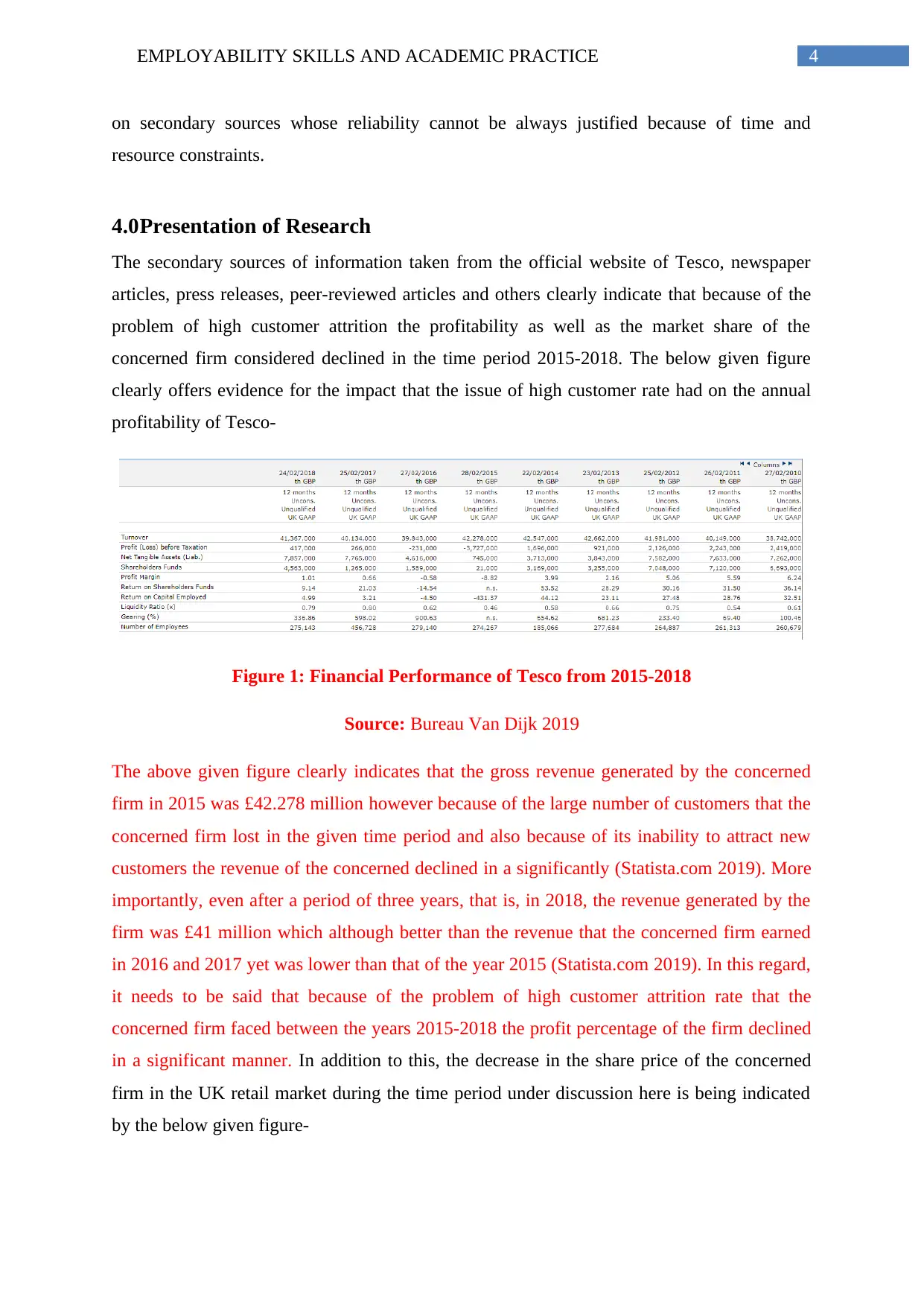
4EMPLOYABILITY SKILLS AND ACADEMIC PRACTICE
on secondary sources whose reliability cannot be always justified because of time and
resource constraints.
4.0Presentation of Research
The secondary sources of information taken from the official website of Tesco, newspaper
articles, press releases, peer-reviewed articles and others clearly indicate that because of the
problem of high customer attrition the profitability as well as the market share of the
concerned firm considered declined in the time period 2015-2018. The below given figure
clearly offers evidence for the impact that the issue of high customer rate had on the annual
profitability of Tesco-
Figure 1: Financial Performance of Tesco from 2015-2018
Source: Bureau Van Dijk 2019
The above given figure clearly indicates that the gross revenue generated by the concerned
firm in 2015 was £42.278 million however because of the large number of customers that the
concerned firm lost in the given time period and also because of its inability to attract new
customers the revenue of the concerned declined in a significantly (Statista.com 2019). More
importantly, even after a period of three years, that is, in 2018, the revenue generated by the
firm was £41 million which although better than the revenue that the concerned firm earned
in 2016 and 2017 yet was lower than that of the year 2015 (Statista.com 2019). In this regard,
it needs to be said that because of the problem of high customer attrition rate that the
concerned firm faced between the years 2015-2018 the profit percentage of the firm declined
in a significant manner. In addition to this, the decrease in the share price of the concerned
firm in the UK retail market during the time period under discussion here is being indicated
by the below given figure-
on secondary sources whose reliability cannot be always justified because of time and
resource constraints.
4.0Presentation of Research
The secondary sources of information taken from the official website of Tesco, newspaper
articles, press releases, peer-reviewed articles and others clearly indicate that because of the
problem of high customer attrition the profitability as well as the market share of the
concerned firm considered declined in the time period 2015-2018. The below given figure
clearly offers evidence for the impact that the issue of high customer rate had on the annual
profitability of Tesco-
Figure 1: Financial Performance of Tesco from 2015-2018
Source: Bureau Van Dijk 2019
The above given figure clearly indicates that the gross revenue generated by the concerned
firm in 2015 was £42.278 million however because of the large number of customers that the
concerned firm lost in the given time period and also because of its inability to attract new
customers the revenue of the concerned declined in a significantly (Statista.com 2019). More
importantly, even after a period of three years, that is, in 2018, the revenue generated by the
firm was £41 million which although better than the revenue that the concerned firm earned
in 2016 and 2017 yet was lower than that of the year 2015 (Statista.com 2019). In this regard,
it needs to be said that because of the problem of high customer attrition rate that the
concerned firm faced between the years 2015-2018 the profit percentage of the firm declined
in a significant manner. In addition to this, the decrease in the share price of the concerned
firm in the UK retail market during the time period under discussion here is being indicated
by the below given figure-
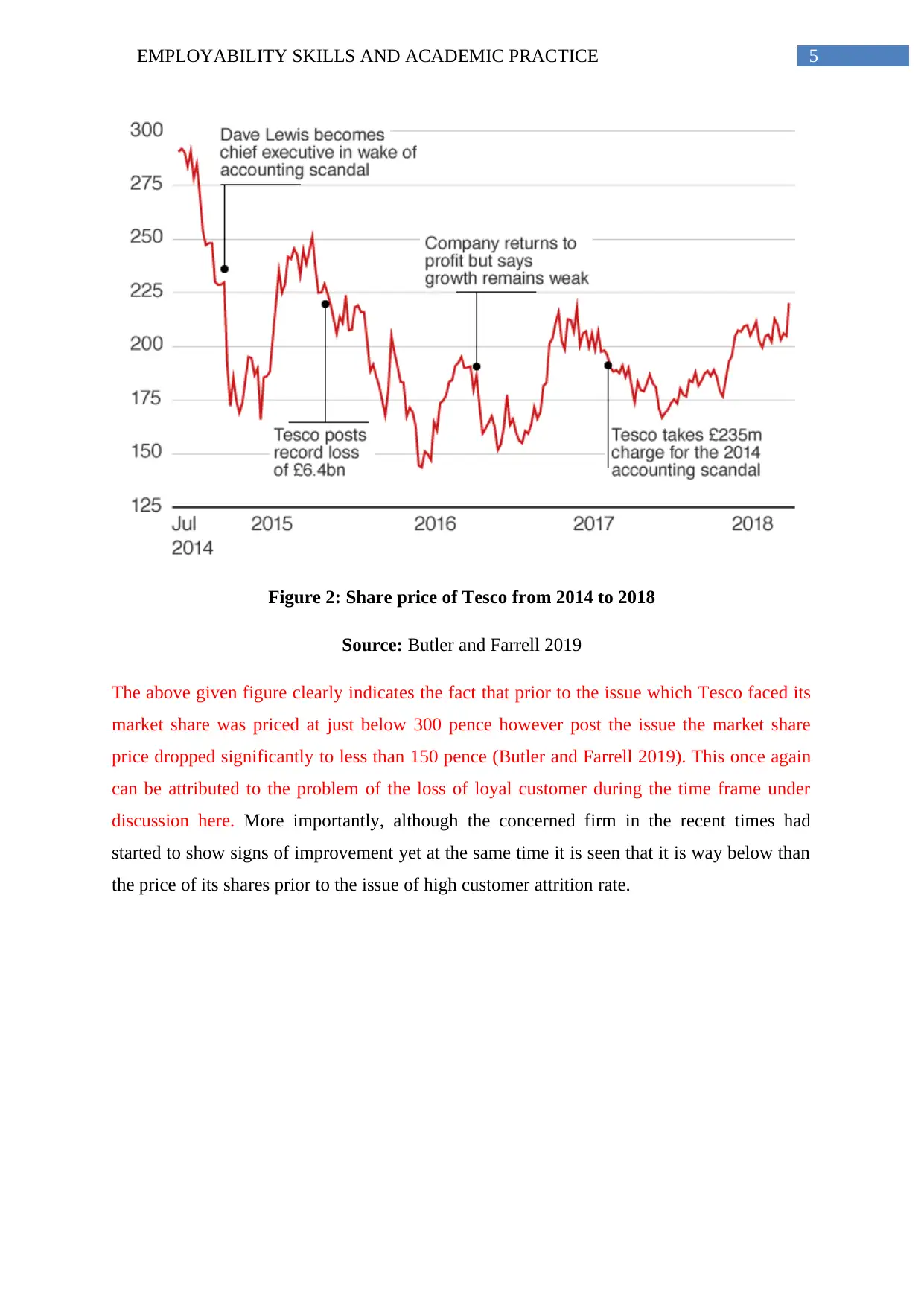
5EMPLOYABILITY SKILLS AND ACADEMIC PRACTICE
Figure 2: Share price of Tesco from 2014 to 2018
Source: Butler and Farrell 2019
The above given figure clearly indicates the fact that prior to the issue which Tesco faced its
market share was priced at just below 300 pence however post the issue the market share
price dropped significantly to less than 150 pence (Butler and Farrell 2019). This once again
can be attributed to the problem of the loss of loyal customer during the time frame under
discussion here. More importantly, although the concerned firm in the recent times had
started to show signs of improvement yet at the same time it is seen that it is way below than
the price of its shares prior to the issue of high customer attrition rate.
Figure 2: Share price of Tesco from 2014 to 2018
Source: Butler and Farrell 2019
The above given figure clearly indicates the fact that prior to the issue which Tesco faced its
market share was priced at just below 300 pence however post the issue the market share
price dropped significantly to less than 150 pence (Butler and Farrell 2019). This once again
can be attributed to the problem of the loss of loyal customer during the time frame under
discussion here. More importantly, although the concerned firm in the recent times had
started to show signs of improvement yet at the same time it is seen that it is way below than
the price of its shares prior to the issue of high customer attrition rate.
⊘ This is a preview!⊘
Do you want full access?
Subscribe today to unlock all pages.

Trusted by 1+ million students worldwide
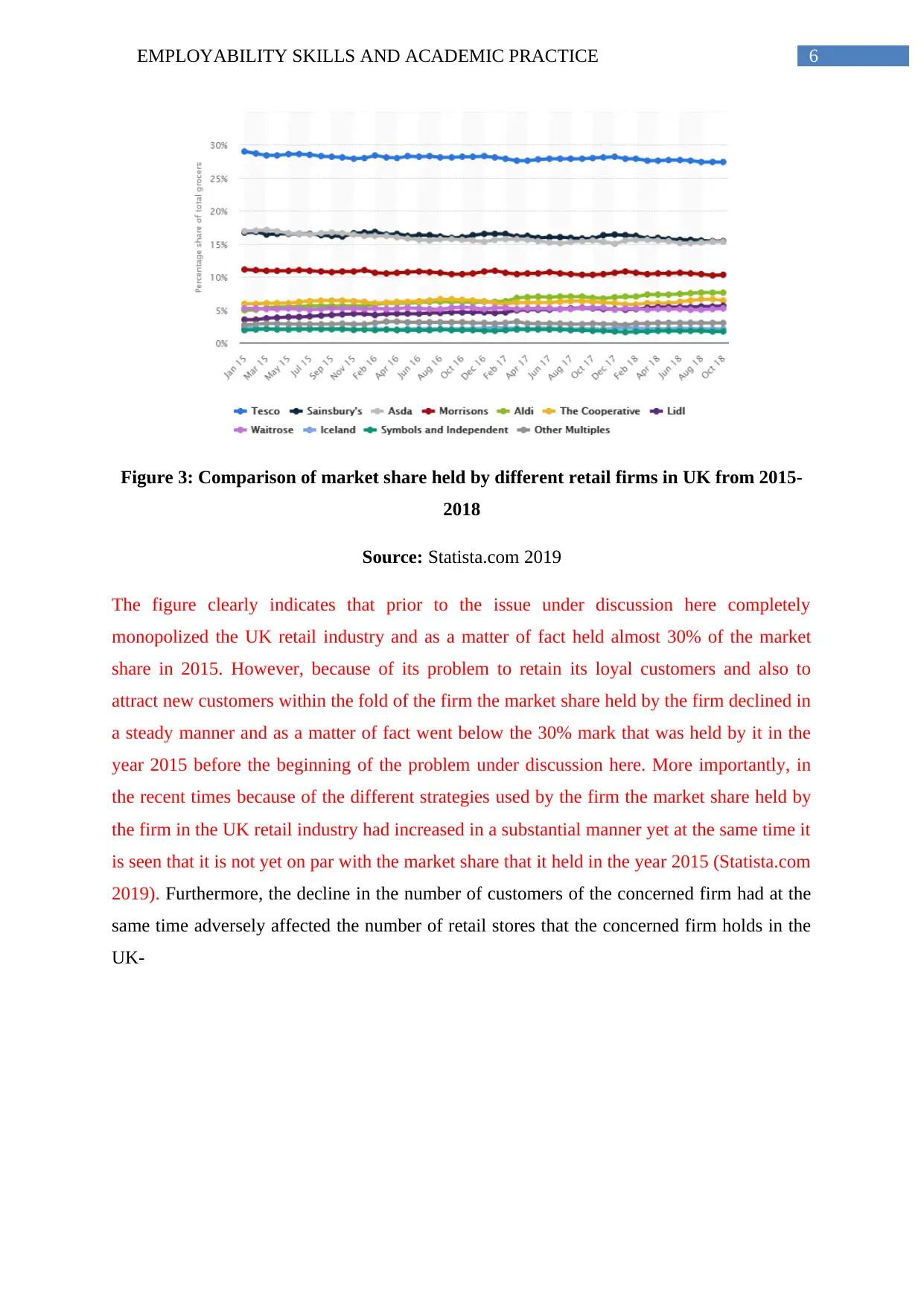
6EMPLOYABILITY SKILLS AND ACADEMIC PRACTICE
Figure 3: Comparison of market share held by different retail firms in UK from 2015-
2018
Source: Statista.com 2019
The figure clearly indicates that prior to the issue under discussion here completely
monopolized the UK retail industry and as a matter of fact held almost 30% of the market
share in 2015. However, because of its problem to retain its loyal customers and also to
attract new customers within the fold of the firm the market share held by the firm declined in
a steady manner and as a matter of fact went below the 30% mark that was held by it in the
year 2015 before the beginning of the problem under discussion here. More importantly, in
the recent times because of the different strategies used by the firm the market share held by
the firm in the UK retail industry had increased in a substantial manner yet at the same time it
is seen that it is not yet on par with the market share that it held in the year 2015 (Statista.com
2019). Furthermore, the decline in the number of customers of the concerned firm had at the
same time adversely affected the number of retail stores that the concerned firm holds in the
UK-
Figure 3: Comparison of market share held by different retail firms in UK from 2015-
2018
Source: Statista.com 2019
The figure clearly indicates that prior to the issue under discussion here completely
monopolized the UK retail industry and as a matter of fact held almost 30% of the market
share in 2015. However, because of its problem to retain its loyal customers and also to
attract new customers within the fold of the firm the market share held by the firm declined in
a steady manner and as a matter of fact went below the 30% mark that was held by it in the
year 2015 before the beginning of the problem under discussion here. More importantly, in
the recent times because of the different strategies used by the firm the market share held by
the firm in the UK retail industry had increased in a substantial manner yet at the same time it
is seen that it is not yet on par with the market share that it held in the year 2015 (Statista.com
2019). Furthermore, the decline in the number of customers of the concerned firm had at the
same time adversely affected the number of retail stores that the concerned firm holds in the
UK-
Paraphrase This Document
Need a fresh take? Get an instant paraphrase of this document with our AI Paraphraser
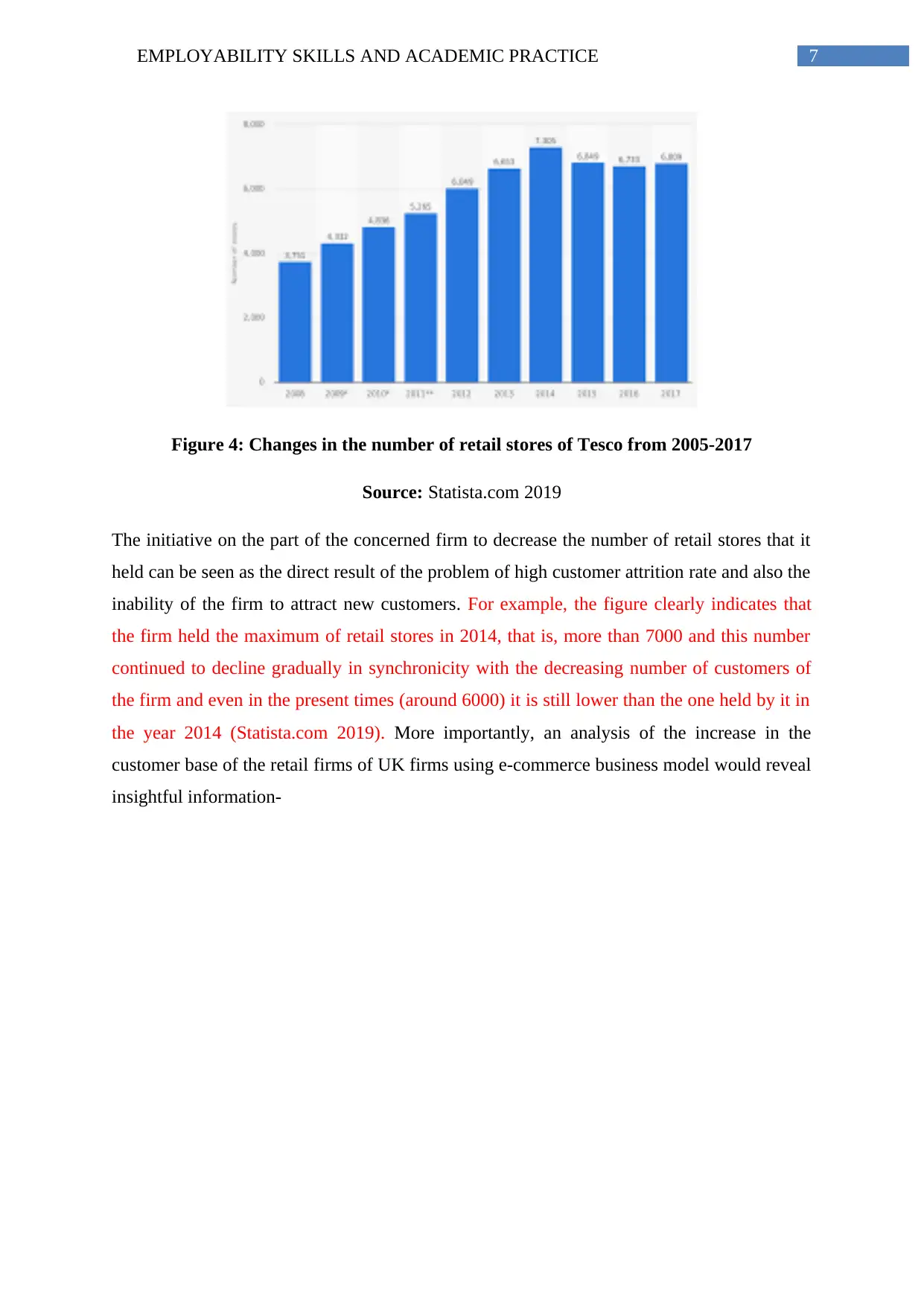
7EMPLOYABILITY SKILLS AND ACADEMIC PRACTICE
Figure 4: Changes in the number of retail stores of Tesco from 2005-2017
Source: Statista.com 2019
The initiative on the part of the concerned firm to decrease the number of retail stores that it
held can be seen as the direct result of the problem of high customer attrition rate and also the
inability of the firm to attract new customers. For example, the figure clearly indicates that
the firm held the maximum of retail stores in 2014, that is, more than 7000 and this number
continued to decline gradually in synchronicity with the decreasing number of customers of
the firm and even in the present times (around 6000) it is still lower than the one held by it in
the year 2014 (Statista.com 2019). More importantly, an analysis of the increase in the
customer base of the retail firms of UK firms using e-commerce business model would reveal
insightful information-
Figure 4: Changes in the number of retail stores of Tesco from 2005-2017
Source: Statista.com 2019
The initiative on the part of the concerned firm to decrease the number of retail stores that it
held can be seen as the direct result of the problem of high customer attrition rate and also the
inability of the firm to attract new customers. For example, the figure clearly indicates that
the firm held the maximum of retail stores in 2014, that is, more than 7000 and this number
continued to decline gradually in synchronicity with the decreasing number of customers of
the firm and even in the present times (around 6000) it is still lower than the one held by it in
the year 2014 (Statista.com 2019). More importantly, an analysis of the increase in the
customer base of the retail firms of UK firms using e-commerce business model would reveal
insightful information-
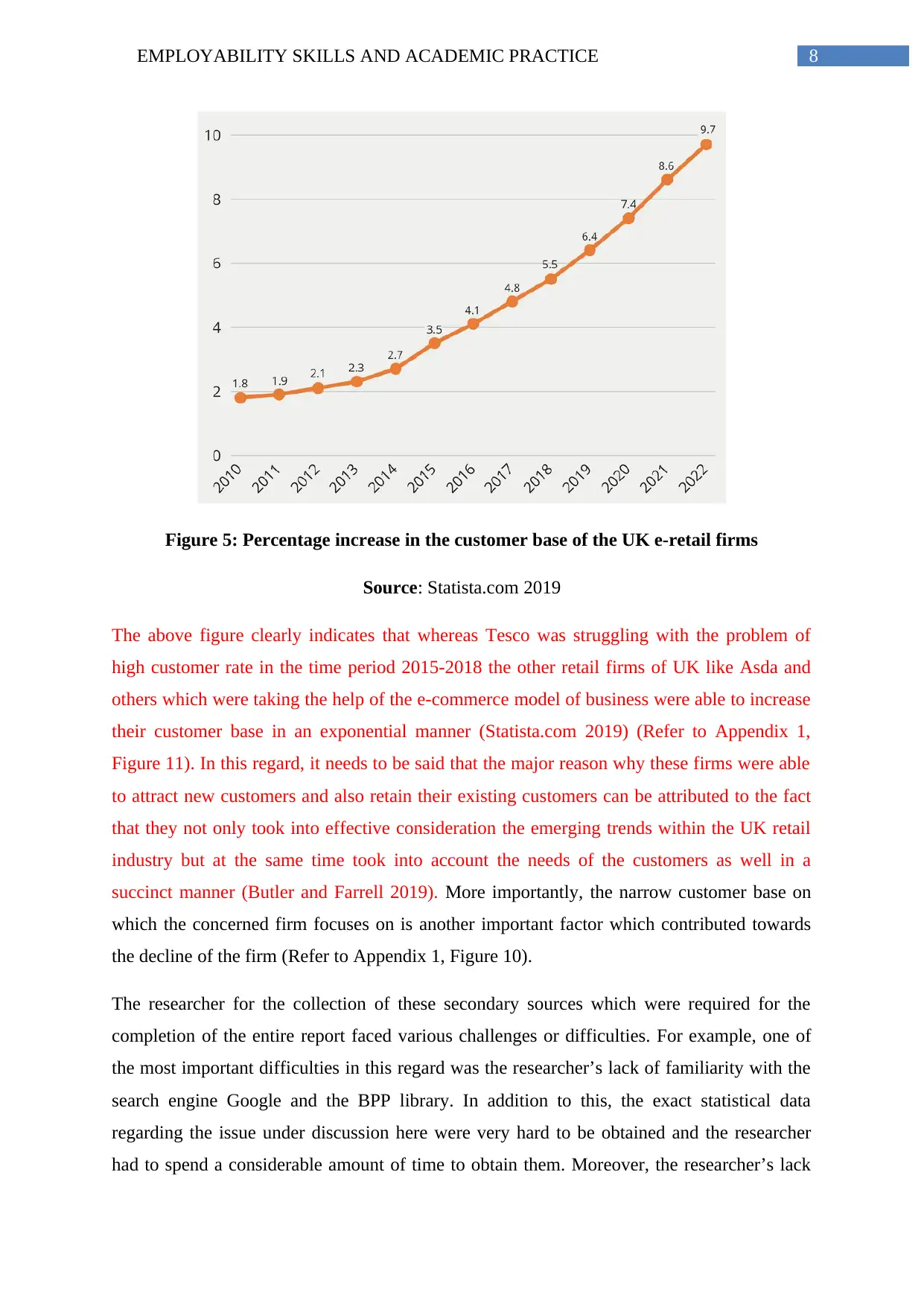
8EMPLOYABILITY SKILLS AND ACADEMIC PRACTICE
Figure 5: Percentage increase in the customer base of the UK e-retail firms
Source: Statista.com 2019
The above figure clearly indicates that whereas Tesco was struggling with the problem of
high customer rate in the time period 2015-2018 the other retail firms of UK like Asda and
others which were taking the help of the e-commerce model of business were able to increase
their customer base in an exponential manner (Statista.com 2019) (Refer to Appendix 1,
Figure 11). In this regard, it needs to be said that the major reason why these firms were able
to attract new customers and also retain their existing customers can be attributed to the fact
that they not only took into effective consideration the emerging trends within the UK retail
industry but at the same time took into account the needs of the customers as well in a
succinct manner (Butler and Farrell 2019). More importantly, the narrow customer base on
which the concerned firm focuses on is another important factor which contributed towards
the decline of the firm (Refer to Appendix 1, Figure 10).
The researcher for the collection of these secondary sources which were required for the
completion of the entire report faced various challenges or difficulties. For example, one of
the most important difficulties in this regard was the researcher’s lack of familiarity with the
search engine Google and the BPP library. In addition to this, the exact statistical data
regarding the issue under discussion here were very hard to be obtained and the researcher
had to spend a considerable amount of time to obtain them. Moreover, the researcher’s lack
Figure 5: Percentage increase in the customer base of the UK e-retail firms
Source: Statista.com 2019
The above figure clearly indicates that whereas Tesco was struggling with the problem of
high customer rate in the time period 2015-2018 the other retail firms of UK like Asda and
others which were taking the help of the e-commerce model of business were able to increase
their customer base in an exponential manner (Statista.com 2019) (Refer to Appendix 1,
Figure 11). In this regard, it needs to be said that the major reason why these firms were able
to attract new customers and also retain their existing customers can be attributed to the fact
that they not only took into effective consideration the emerging trends within the UK retail
industry but at the same time took into account the needs of the customers as well in a
succinct manner (Butler and Farrell 2019). More importantly, the narrow customer base on
which the concerned firm focuses on is another important factor which contributed towards
the decline of the firm (Refer to Appendix 1, Figure 10).
The researcher for the collection of these secondary sources which were required for the
completion of the entire report faced various challenges or difficulties. For example, one of
the most important difficulties in this regard was the researcher’s lack of familiarity with the
search engine Google and the BPP library. In addition to this, the exact statistical data
regarding the issue under discussion here were very hard to be obtained and the researcher
had to spend a considerable amount of time to obtain them. Moreover, the researcher’s lack
⊘ This is a preview!⊘
Do you want full access?
Subscribe today to unlock all pages.

Trusted by 1+ million students worldwide
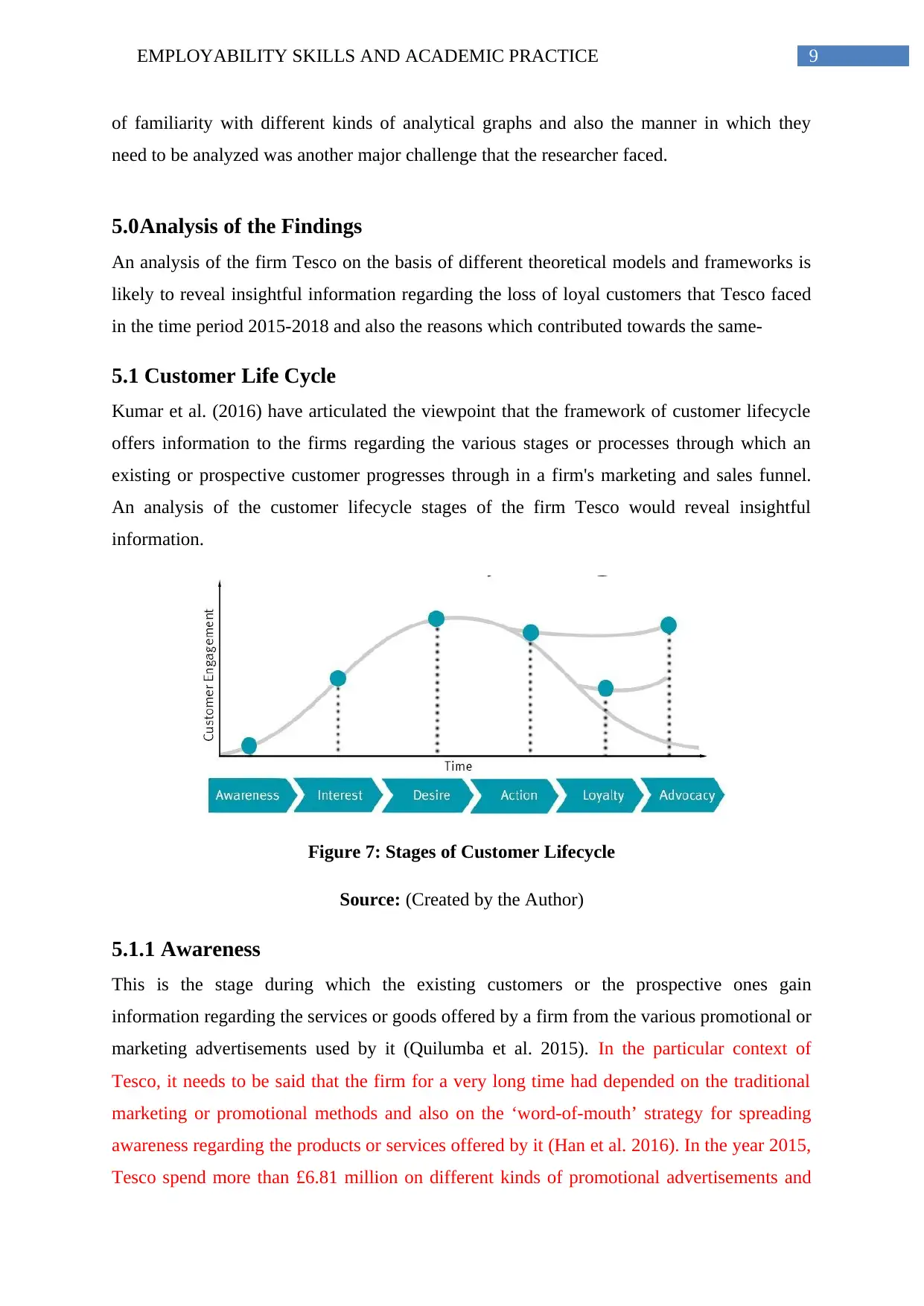
9EMPLOYABILITY SKILLS AND ACADEMIC PRACTICE
of familiarity with different kinds of analytical graphs and also the manner in which they
need to be analyzed was another major challenge that the researcher faced.
5.0Analysis of the Findings
An analysis of the firm Tesco on the basis of different theoretical models and frameworks is
likely to reveal insightful information regarding the loss of loyal customers that Tesco faced
in the time period 2015-2018 and also the reasons which contributed towards the same-
5.1 Customer Life Cycle
Kumar et al. (2016) have articulated the viewpoint that the framework of customer lifecycle
offers information to the firms regarding the various stages or processes through which an
existing or prospective customer progresses through in a firm's marketing and sales funnel.
An analysis of the customer lifecycle stages of the firm Tesco would reveal insightful
information.
Figure 7: Stages of Customer Lifecycle
Source: (Created by the Author)
5.1.1 Awareness
This is the stage during which the existing customers or the prospective ones gain
information regarding the services or goods offered by a firm from the various promotional or
marketing advertisements used by it (Quilumba et al. 2015). In the particular context of
Tesco, it needs to be said that the firm for a very long time had depended on the traditional
marketing or promotional methods and also on the ‘word-of-mouth’ strategy for spreading
awareness regarding the products or services offered by it (Han et al. 2016). In the year 2015,
Tesco spend more than £6.81 million on different kinds of promotional advertisements and
of familiarity with different kinds of analytical graphs and also the manner in which they
need to be analyzed was another major challenge that the researcher faced.
5.0Analysis of the Findings
An analysis of the firm Tesco on the basis of different theoretical models and frameworks is
likely to reveal insightful information regarding the loss of loyal customers that Tesco faced
in the time period 2015-2018 and also the reasons which contributed towards the same-
5.1 Customer Life Cycle
Kumar et al. (2016) have articulated the viewpoint that the framework of customer lifecycle
offers information to the firms regarding the various stages or processes through which an
existing or prospective customer progresses through in a firm's marketing and sales funnel.
An analysis of the customer lifecycle stages of the firm Tesco would reveal insightful
information.
Figure 7: Stages of Customer Lifecycle
Source: (Created by the Author)
5.1.1 Awareness
This is the stage during which the existing customers or the prospective ones gain
information regarding the services or goods offered by a firm from the various promotional or
marketing advertisements used by it (Quilumba et al. 2015). In the particular context of
Tesco, it needs to be said that the firm for a very long time had depended on the traditional
marketing or promotional methods and also on the ‘word-of-mouth’ strategy for spreading
awareness regarding the products or services offered by it (Han et al. 2016). In the year 2015,
Tesco spend more than £6.81 million on different kinds of promotional advertisements and
Paraphrase This Document
Need a fresh take? Get an instant paraphrase of this document with our AI Paraphraser
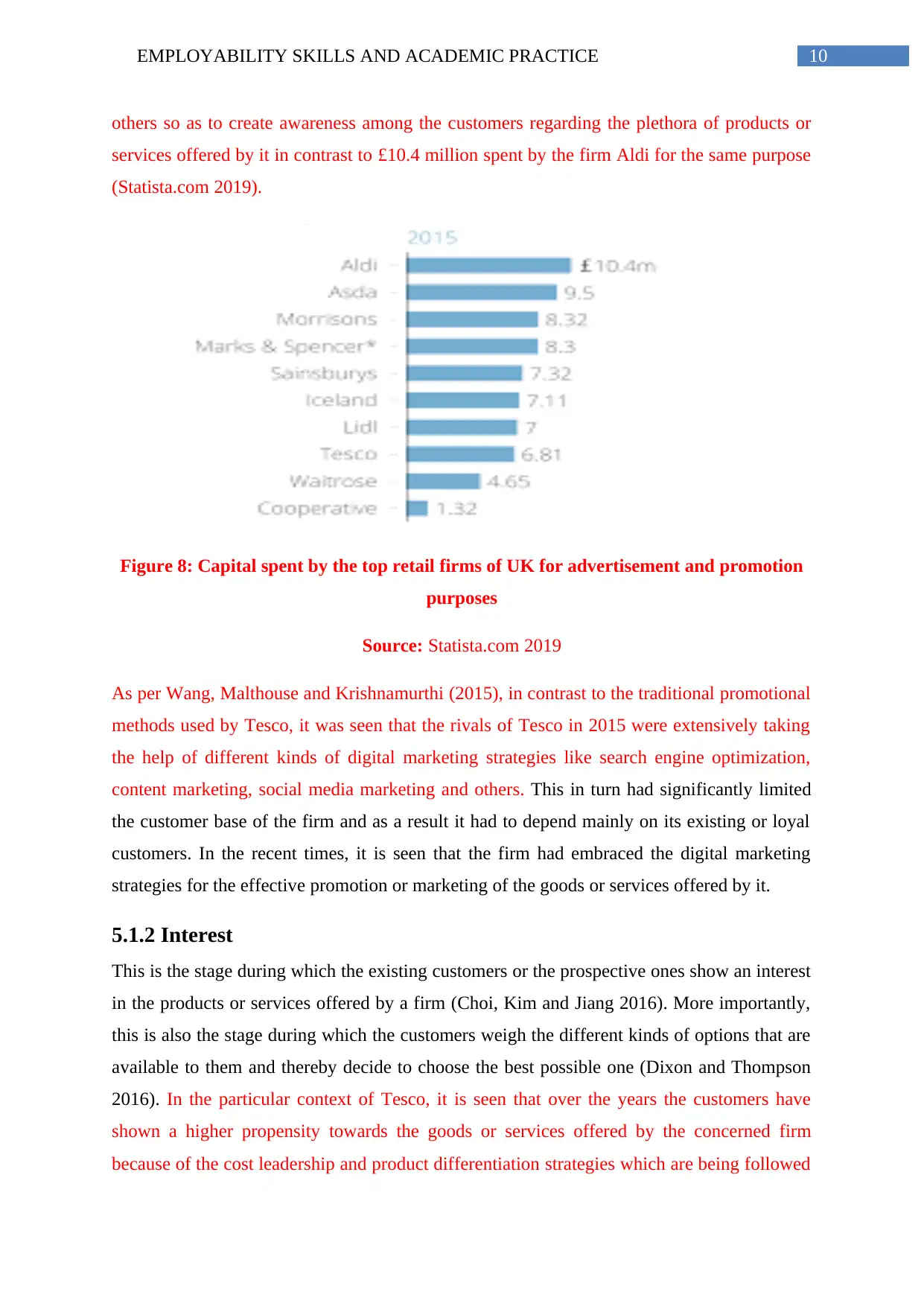
10EMPLOYABILITY SKILLS AND ACADEMIC PRACTICE
others so as to create awareness among the customers regarding the plethora of products or
services offered by it in contrast to £10.4 million spent by the firm Aldi for the same purpose
(Statista.com 2019).
Figure 8: Capital spent by the top retail firms of UK for advertisement and promotion
purposes
Source: Statista.com 2019
As per Wang, Malthouse and Krishnamurthi (2015), in contrast to the traditional promotional
methods used by Tesco, it was seen that the rivals of Tesco in 2015 were extensively taking
the help of different kinds of digital marketing strategies like search engine optimization,
content marketing, social media marketing and others. This in turn had significantly limited
the customer base of the firm and as a result it had to depend mainly on its existing or loyal
customers. In the recent times, it is seen that the firm had embraced the digital marketing
strategies for the effective promotion or marketing of the goods or services offered by it.
5.1.2 Interest
This is the stage during which the existing customers or the prospective ones show an interest
in the products or services offered by a firm (Choi, Kim and Jiang 2016). More importantly,
this is also the stage during which the customers weigh the different kinds of options that are
available to them and thereby decide to choose the best possible one (Dixon and Thompson
2016). In the particular context of Tesco, it is seen that over the years the customers have
shown a higher propensity towards the goods or services offered by the concerned firm
because of the cost leadership and product differentiation strategies which are being followed
others so as to create awareness among the customers regarding the plethora of products or
services offered by it in contrast to £10.4 million spent by the firm Aldi for the same purpose
(Statista.com 2019).
Figure 8: Capital spent by the top retail firms of UK for advertisement and promotion
purposes
Source: Statista.com 2019
As per Wang, Malthouse and Krishnamurthi (2015), in contrast to the traditional promotional
methods used by Tesco, it was seen that the rivals of Tesco in 2015 were extensively taking
the help of different kinds of digital marketing strategies like search engine optimization,
content marketing, social media marketing and others. This in turn had significantly limited
the customer base of the firm and as a result it had to depend mainly on its existing or loyal
customers. In the recent times, it is seen that the firm had embraced the digital marketing
strategies for the effective promotion or marketing of the goods or services offered by it.
5.1.2 Interest
This is the stage during which the existing customers or the prospective ones show an interest
in the products or services offered by a firm (Choi, Kim and Jiang 2016). More importantly,
this is also the stage during which the customers weigh the different kinds of options that are
available to them and thereby decide to choose the best possible one (Dixon and Thompson
2016). In the particular context of Tesco, it is seen that over the years the customers have
shown a higher propensity towards the goods or services offered by the concerned firm
because of the cost leadership and product differentiation strategies which are being followed
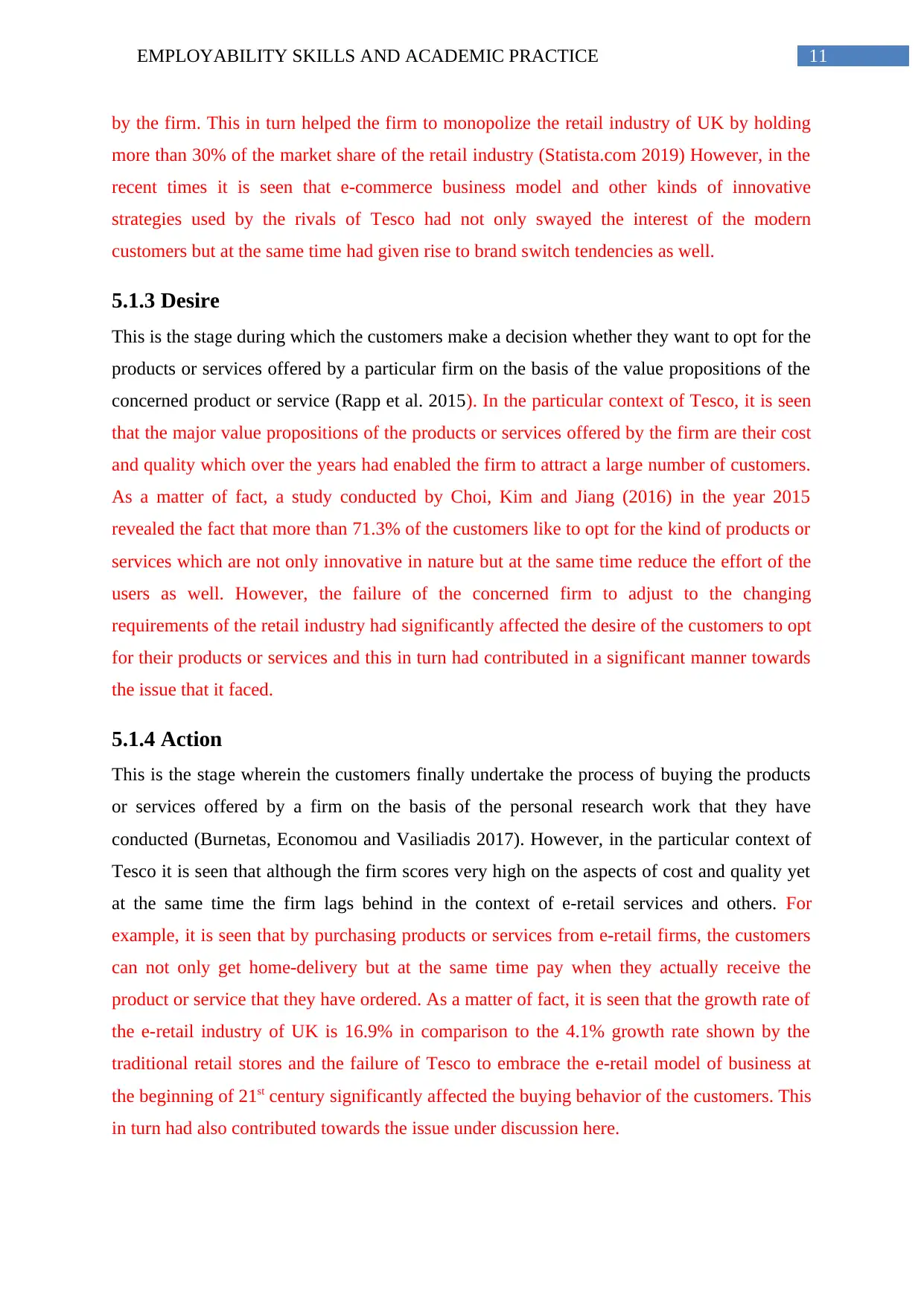
11EMPLOYABILITY SKILLS AND ACADEMIC PRACTICE
by the firm. This in turn helped the firm to monopolize the retail industry of UK by holding
more than 30% of the market share of the retail industry (Statista.com 2019) However, in the
recent times it is seen that e-commerce business model and other kinds of innovative
strategies used by the rivals of Tesco had not only swayed the interest of the modern
customers but at the same time had given rise to brand switch tendencies as well.
5.1.3 Desire
This is the stage during which the customers make a decision whether they want to opt for the
products or services offered by a particular firm on the basis of the value propositions of the
concerned product or service (Rapp et al. 2015). In the particular context of Tesco, it is seen
that the major value propositions of the products or services offered by the firm are their cost
and quality which over the years had enabled the firm to attract a large number of customers.
As a matter of fact, a study conducted by Choi, Kim and Jiang (2016) in the year 2015
revealed the fact that more than 71.3% of the customers like to opt for the kind of products or
services which are not only innovative in nature but at the same time reduce the effort of the
users as well. However, the failure of the concerned firm to adjust to the changing
requirements of the retail industry had significantly affected the desire of the customers to opt
for their products or services and this in turn had contributed in a significant manner towards
the issue that it faced.
5.1.4 Action
This is the stage wherein the customers finally undertake the process of buying the products
or services offered by a firm on the basis of the personal research work that they have
conducted (Burnetas, Economou and Vasiliadis 2017). However, in the particular context of
Tesco it is seen that although the firm scores very high on the aspects of cost and quality yet
at the same time the firm lags behind in the context of e-retail services and others. For
example, it is seen that by purchasing products or services from e-retail firms, the customers
can not only get home-delivery but at the same time pay when they actually receive the
product or service that they have ordered. As a matter of fact, it is seen that the growth rate of
the e-retail industry of UK is 16.9% in comparison to the 4.1% growth rate shown by the
traditional retail stores and the failure of Tesco to embrace the e-retail model of business at
the beginning of 21st century significantly affected the buying behavior of the customers. This
in turn had also contributed towards the issue under discussion here.
by the firm. This in turn helped the firm to monopolize the retail industry of UK by holding
more than 30% of the market share of the retail industry (Statista.com 2019) However, in the
recent times it is seen that e-commerce business model and other kinds of innovative
strategies used by the rivals of Tesco had not only swayed the interest of the modern
customers but at the same time had given rise to brand switch tendencies as well.
5.1.3 Desire
This is the stage during which the customers make a decision whether they want to opt for the
products or services offered by a particular firm on the basis of the value propositions of the
concerned product or service (Rapp et al. 2015). In the particular context of Tesco, it is seen
that the major value propositions of the products or services offered by the firm are their cost
and quality which over the years had enabled the firm to attract a large number of customers.
As a matter of fact, a study conducted by Choi, Kim and Jiang (2016) in the year 2015
revealed the fact that more than 71.3% of the customers like to opt for the kind of products or
services which are not only innovative in nature but at the same time reduce the effort of the
users as well. However, the failure of the concerned firm to adjust to the changing
requirements of the retail industry had significantly affected the desire of the customers to opt
for their products or services and this in turn had contributed in a significant manner towards
the issue that it faced.
5.1.4 Action
This is the stage wherein the customers finally undertake the process of buying the products
or services offered by a firm on the basis of the personal research work that they have
conducted (Burnetas, Economou and Vasiliadis 2017). However, in the particular context of
Tesco it is seen that although the firm scores very high on the aspects of cost and quality yet
at the same time the firm lags behind in the context of e-retail services and others. For
example, it is seen that by purchasing products or services from e-retail firms, the customers
can not only get home-delivery but at the same time pay when they actually receive the
product or service that they have ordered. As a matter of fact, it is seen that the growth rate of
the e-retail industry of UK is 16.9% in comparison to the 4.1% growth rate shown by the
traditional retail stores and the failure of Tesco to embrace the e-retail model of business at
the beginning of 21st century significantly affected the buying behavior of the customers. This
in turn had also contributed towards the issue under discussion here.
⊘ This is a preview!⊘
Do you want full access?
Subscribe today to unlock all pages.

Trusted by 1+ million students worldwide
1 out of 27
Related Documents
Your All-in-One AI-Powered Toolkit for Academic Success.
+13062052269
info@desklib.com
Available 24*7 on WhatsApp / Email
![[object Object]](/_next/static/media/star-bottom.7253800d.svg)
Unlock your academic potential
Copyright © 2020–2025 A2Z Services. All Rights Reserved. Developed and managed by ZUCOL.




